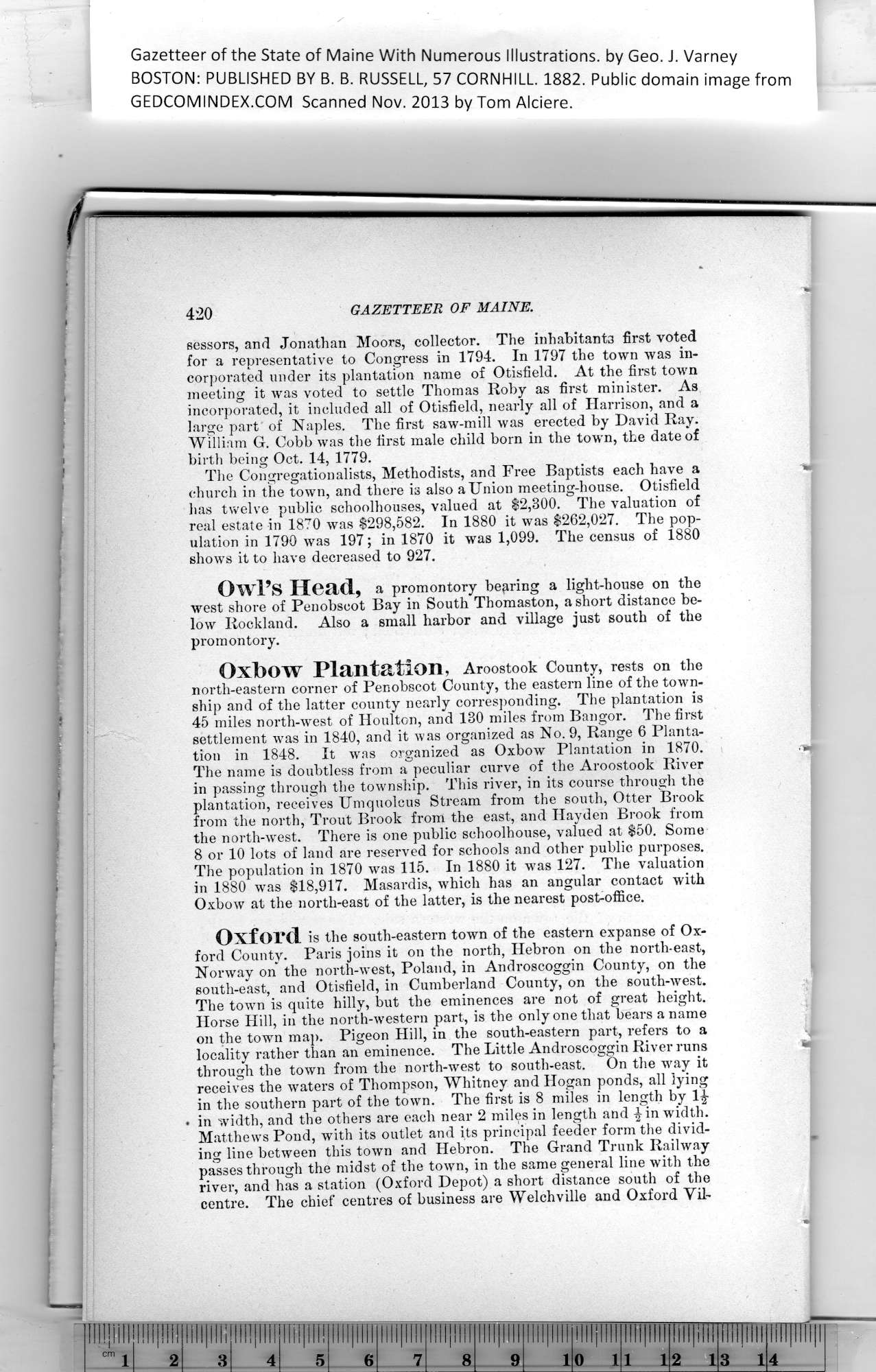|
Gazetteer of the State of Maine With Numerous Illustrations, by Geo. J. Varney
BOSTON: PUBLISHED BY B. B. RUSSELL, 57 CORNHILL. 1882. Public domain image from
420 GAZETTEER OF MAINE.
sessors, and Jonathan Moors, collector. The inhabitants first voted
for a representative to Congress in 1794. In 1797 the town was in-
corporated under its plantation name of Otisfield. At the first town
meeting it was voted to settle Thomas Roby as first minister. As
incorporated, it included all of Otisfield, nearly all of Harrison, and a
large part of Naples. The first saw-mill was erected by David Ray.
William G. Cobb was the first male child born in the town, tbe date of
birth being Oct. 14, 1779.
The Congregationalists, Methodists, and Free Baptists each have a
church in the town, and there is also a Union meeting-house. Otisfield
lias twelve public schoolhouses, valued at $2,300. The valuation of
real estate in 1870 was $298,582. In 1880 it was $262,027. The pop-
ulation in 1790 was 197; in 1870 it was 1,099. The census of 1880
shows it to have decreased to 927.
Owl’s Head, a promontory bearing a light-house on the
west shore of Penobscot Bay in South Thomaston, a short distance be-
low Rockland. Also a small harbor and village just south of the
promontory.
Oxbow Plantation, Aroostook County, rests on the
north-eastern corner of Penobscot County, the eastern line of the town-
ship and of tbe latter county nearly corresponding. The plantation is
45 miles north-west of Houlton, and 130 miles from Bangor. The first
settlement was in 1840, and it was organized as No. 9, Range 6 Planta-
tion in 1848. It was organized as Oxbow Plantation in 1870.
The name is doubtless from a peculiar curve of the Aroostook River
in passing through the township. This river, in its course through the
plantation, receives Umquolcus Stream from the south, Otter Brook
from the north, Trout Brook from the east, and Hayden Brook from
the north-west. There is one public schoolhouse, valued at $50. Some
8 or 10 lots of land are reserved for schools and other public purposes.
The population in 1870 was 115. In 1880 it was 127. The valuation
in 1880 was $18,917. Masardis, which has an angular contact with
Oxbow at the north-east of the latter, is the nearest post-office.
Oxford is the south-eastern town of the eastern expanse of Ox-
ford County. Paris joins it on the north, Hebron on the north-east,
Norway on the north-west, Poland, in Androscoggin County, on the
south-east, and Otisfield, in Cumberland County, on the south-west.
The town is quite hilly, but the eminences are not of great height.
Horse Hill, in the north-western part, is the only one that bears a name
on the town map. Pigeon Hill, in the south-eastern part, refers to a
locality rather than an eminence. The Little Androscoggin River runs
through the town from the north-west to south-east. On the way it
receives the waters of Thompson, Whitney and Hogan ponds, all lying
in the southern part of the town. The first is 8 miles in length by l|-
• in width, and the others are each near 2 miles in length and 4 in width.
Matthews Pond, with its outlet and its principal feeder form the divid-
ing line between this town and Hebron. The Grand Trunk Railway
passes through the midst of the town, in the same general line with the
river, and has a station (Oxford Depot) a short distance south of the
centre. The chief centres of business are Welchville and Oxford Vil-
PREVIOUS PAGE ... NEXT PAGE
This page was written in HTML using a program written in Python 3.2
|
